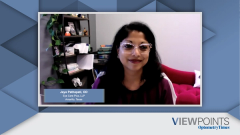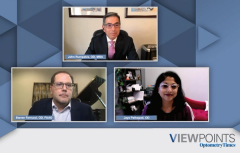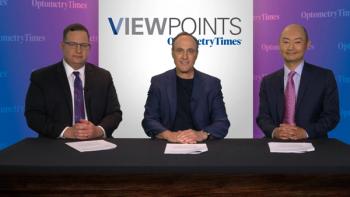
Dry AMD: Current Tools Used to Screen Patients
An overview of the types of strategies that are currently used to screen patients with dry age-related macular degeneration for signs of disease progression
Episodes in this series

John Rumpakis, OD, MBA: Knowing that early diagnosis is the key to the best outcomes that we can possibly get, how does the need or the ability to provide continuous monitoring of disease progression aid you in clinical practice? Jaya, let’s start with you.
Jaya Pathapati, OD: When you’re monitoring, the tools we have, the technology is great—OCT [optical coherence tomography] fundus photos, ERG [electroretinography] VEP [visual-evoked potential] tests—but they ultimately go home. First, as Steve said, they have to keep their appointment for us to review it. What happens to a patient who’s not able to keep their appointment for whatever reason—they forget it or something else? An Amsler test is the old-fashioned way of doing it. I still send my patients home with an Amsler. I think I’m giving them a VHS tape to take home, and we’re streaming now.
The chance of them converting between when I see them till next time is there. As Steve said, a few do convert, and they come in after they’ve lost vision, maybe 20/40, 20/50. We don’t know. I sadly had a patient who went to 20/200 in 6 months. She said, “I was in denial that I had macular degeneration, so that’s why I didn’t come in.” I teared up because this could have been prevented. Unfortunately, she was not able to regain her vision. I did not do my job in educating her—that’s what I learned from that. We talk to the patient and give them those tools, but they have to come in for us to do our job to the next level.
John Rumpakis, OD, MBA: Continuous monitoring would be awesome, right? That would be the utopia where we have a monitoring system going on daily, whether they’re in the office or not, right?
Jaya Pathapati, OD: Exactly.
John Rumpakis, OD, MBA: Steve, are you employing that today?
Steven Ferrucci, OD, FAAO: I feel very similar to what Jaya said. First, I wouldn’t even say an AMS [Amsler] grid is a VHS tape. It might be equivalent to Betamax. I remember Beta. The Amsler grid was invented in 1945 and, at the time, it was probably fine because we didn’t have any treatments for macular degeneration. But now that we have a treatment, and we know treatment can help, we have to do a better job detecting these patients. The problem is, if I see a patient in practice and I see their level of maculopathy and I use other risk factors—whether it’s genetic testing, or family history, or macular pigment ocular density, or whatever—I make an educated guess about when I should see that patient again.
But that’s honestly all it is: an educated guess. If I say I want to see you back in 3 months, as Jaya said, bad things can happen between now and 3 months. They can convert. By continuously monitoring them for the period that we’re not seeing them, and knowing if they have a change that indicates conversion, is very powerful. Because now we don’t monitor them only every 3 months. In essence, we’re monitoring them continuously, and that’s going give better outcomes.
Transcript edited for clarity.
Newsletter
Want more insights like this? Subscribe to Optometry Times and get clinical pearls and practice tips delivered straight to your inbox.









































